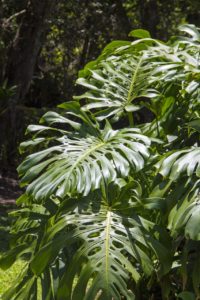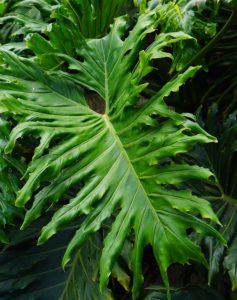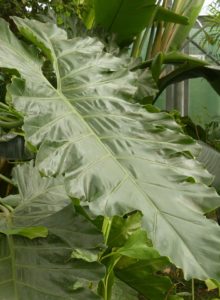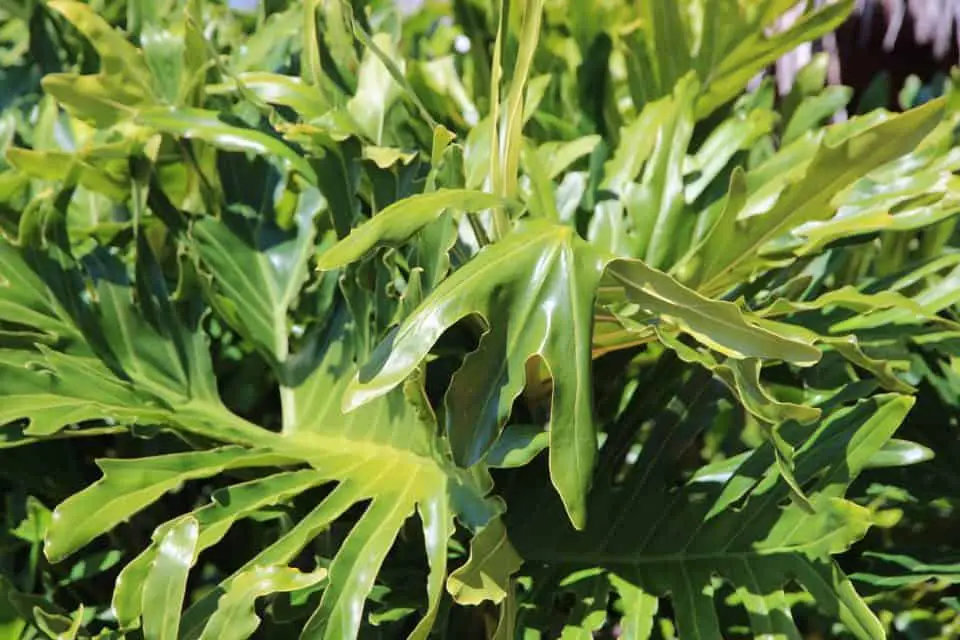Some links in the post are affiliate links and I get a commission from purchases made through some links found in the post.
Philodendron plays an essential role in interior design. Philodendron plants are easy to grow even for rookie houseplant owners since they adapt well to indoor settings.
They brighten up the appearance of your seating space with their lush evergreen foliage. They’re such a visual delight. Hundreds of kinds of gorgeous foliage plants belong to the Philodendron genus.
They generally have big green glossy leaves lending your house a tropical feel. Philodendrons come in two varieties; climbing and non-climbing.
The vining species may reach a height of several feet and typically requires some kind of supporting structure to climb on, such as a trellis or different baskets.
Non-climbing varieties grow erect and make excellent container foliage plants. They have a rapid growth rate.
 Although it’s preferable to grow houseplants in the spring, they may be grown at any time. If swallowed, they are harmful to pets and humans.
Although it’s preferable to grow houseplants in the spring, they may be grown at any time. If swallowed, they are harmful to pets and humans.
Philodendron houseplants perform well indoors all year, but they also love a shaded position outside when the weather allows.
Taking the plant outside also thoroughly cleans the leaves and refreshes the soil with new water. Philodendrons are less stressed when moved from indoor to outdoor environments.
Allow plenty of room for this plant to expand because it trails like a Jungle Boogie Philodendron or split-leaf Philodendron.
The most common philodendron species include Philodendron scandens, Philodendron erubescence, Philodendron melanochrysum, Philodendron Rojo, and Philodendron bipinnatifidum.
How do you Care for a Philodendron Tiger Tooth?
Generally, philodendrons are considered easy plants to grow. Even the beginners do not face any difficulty while growing them.
As a quick care guide for a Philodendron tiger tooth; they need moist organically rich, loose potting soil with bright indirect light.
They like a balance liquid fertilizer and temperatures between 65 to 77 degress Fahrenheit.
Thus, they prove to be very rewarding with their fast growth. The following points should be considered while growing philodendron in your gardens for the best growing results.
Fertilizer
Apply a balanced liquid fertilizer to your plant every month in the spring and summer.
Then, throughout the fall and winter, limit feeding to every seven to eight weeks. If its nourishment is compromised, your philodendron may show any signs of development retardation. Its leaves will be smaller than usual.
Most of the potting soils have sufficient nutrients, which plants use with time while growing.
Your plant will have grown large enough to require a larger container by the time it has drained the nutrients in its soil.
So, repot your Philodendron Narrow Tiger Tooth when it doubles in growth or once a year to replace the nutrients.
If your plant is showing new pale leaves, it indicates that it is not getting enough micronutrients such as calcium and magnesium for its growth.
Try this easy to use fertilizer to give your plant that little boost.
Water
These plants usually like to grow in soil with a moderate amount of moisture. Make sure to water your plant when the upper inch of the soil has dried up.
Allow the top inch (2.5 cm) of soil to dry out between watering’s while cultivating philodendron plants. Inserting your index finger into the soil is an excellent technique to assess the moisture level.
Overwatering and underwatering are the two main factors responsible for the leaves to droop. So, soil dryness is the primary indicator to determine the time to water your plant.
This plant does not behave well in wet soil as this can cause root rot. Water stress is somewhat higher in non-climbing variants than climbing variants. Limit watering for the indoor plants and during winters.
If you need help watering your plant, try using this automatic drip irrigation kit.
Soil
Philodendrons prefer organically rich, loose potting soil. The soil must be well-drained.
Salts that build in the soil due to watering are toxic to these plants and can cause yellowish or brownish discoloration of leaves.
Water your container well until water flows out of the drainage holes to regularly flush away some of the salts. However, the soil will ultimately need to be replenished.
Light

Partially shaded areas are ideal for philodendrons. Choose a location near a window where the sun’s rays will never contact the vegetation.
Under a tropical cover, they would naturally get diffused light rather than direct sunlight. Set them up near a window that receives bright, indirect light indoors.
If there isn’t enough light, the plant will become lanky, and there will be a lot of gaps between the leaves. However, too much light can cause a large number of leaves to become yellow at once.
If your plant is struggling due to light, trying using this to help regulate the lighting.
Humidity and Temperature
Their temperature tolerance varies with each species. Temperatures below 55 degrees Fahrenheit are harmful to this plant.
Because these plants prefer humidity, you may need to increase humidity around your philodendron if you live in a dry environment.
You may accomplish this by misting the plant with water from a spray bottle every few days.
You may also set the pot on a platter of marbles submerged, making sure that the container’s base does not come into contact with the water, which could cause root disease.
If you’re enjoying this article, check out our article on can a philodendron be put outside.
How Big Does a Tiger Tooth Philodendron Get?
Tiger Tooth Philodendrons may grow to be 10 inches tall in their natural habitat. They grow parasitically on tree trunks and fallen old growth-producing canopy that stretches over 3 inches long.
When grown inside, however, your Tiger Tooth Philodendron should reach a height of 2-1/2 inches with older leaves 2 inches long.
How to Propagate a Philodendron Tiger Tooth?
Philodendrons can be propagated in two ways; Stem cutting and division.
For the stem cutting method, disinfected pruning cutters or heavy-duty scissors, planting mix, a container, and, if desired, a rooting hormone is all that is required.
To grow roots, cut a 6-inch section of the stem and insert it in a water container. As the water evaporates, add more. Pot the cutting in wet soil once numerous roots have formed (typically within two weeks).
For division, Plantlets from philodendrons can be taken from the main plant with their roots undamaged and replanted after they reach a length of several inches.
Withdraw the plant from its present pot, lay it on a level, solid surface, detach the root system with your fingers, and remove the plantlet with its roots out.
Philodendron Tiger Tooth vs Ring of Fire
The Philodendron’ Ring of Fire’ is one of the world’s most beautiful and requested Philodendrons. The color of the leaves can vary from sunset orange to brick red, pink to deep green.
Mottled, spotted, blotched, or even striped patterns can be found on the leaves.
In contrast to tiger tooth, it’s a philodendron that takes a long time to grow, but it’s definitely worth the effort.
Philodendron’ Ring of Fire’ was previously known as ‘Henderson’s Pride’ and is thought to be a blend of Philodendron Tortum and Philodendron Wendlandii.
It can reach a height of 120cm and has 35cm wide leaves. This plant is 25cm tall with 2-4 leaves and comes in a 12cm plastic nursery container.
It requires bright but indirect sunlight, well-drained soil with moderate humidity. Water the plant when the top 3 cm of the soil is dry to touch.
You may also like: Can a philodendron grow in shade
Philodendron Tiger Tooth vs Jungle Boogie
Jungle Boogie is the other name for philodendron tiger tooth. These philodendrons are known for their characteristic jagged tooth-shaped narrow leaves.
They have long, thin leaves with serrated edges. Leaves can grow to be 2-3 feet long. Leaves are bright green to yellow.
Its leaves become more prominent and alter shape somewhat as they mature, while the serrated margin becomes more pronounced.
It requires bright but indirect sunlight to grow. Soil should be moist. It’s an appealing, convenient plant that lends oriental charm to low-light areas of the home that need some foliage.
Final Thoughts
 Philodendron is a large genus of flowering plants belonging to the family Araceae. It’s a classic ornamental plant easy and rapid to grow, perfect for beginners.
Philodendron is a large genus of flowering plants belonging to the family Araceae. It’s a classic ornamental plant easy and rapid to grow, perfect for beginners.
This makes it a widespread indoor plant that you can get easily from your local garden shop. Because the philodendron family is so large, you may discover a wide choice of plants in all forms, sizes, and colours.
So, it gives you a lot of options for your indoor spaces. Many classic philodendron types are vines grown on totems, trellises, or hanging baskets, and others have attractive variegated leaves.
They come in non-climbing varieties as well. With proper bright in directed sunlight and well-drained moist soil enriched with organic nutrients and proper watering, these are the easiest houseplants to cultivate.
Philodendrons that grow upright are just as easy to cultivate, but their leaves are generally more giant. There are mainly two ways by which they can be propagated by stem cutting and division.
Philodendron ring of fire is a unique hybrid variety that comes with sunset to brick red colored leaves. It is thought to be a blend of Philodendron Tortum and Philodendron Wendlandii.
Jungle Boogie is another name for Philodendron Tiger Tooth that has long, thin leaves with serrated margins. Philodendron can grow up to 10 inches in height.
In short, philodendrons are low-maintenance plants that will thrive regardless of whether you grow them up a vine or simply leave them to their own devices.
Before you go, here are some more related articles I encourage you to read below to help solve more of your gardening issues:
What is the rarest philodendron
How to Care for a Philodendron Over Winter
What are the Benefits of Having a Philodendron
Why is my Philodendron Brasil Dying
Philodendron Selloum vs Xanadu
How to Fix Your Philodendron Selloum Problems
How to Propagate Philodendrons in Water
About the Author:
Saad Ansar
Saad is an avid gardener himself and is a great lover of plants, animals, photography, & people. Currently, he is focused on photographing indoor plants & captioning beautiful outdoor sceneries. He writes and rewrites in-depth articles on nature and science.


